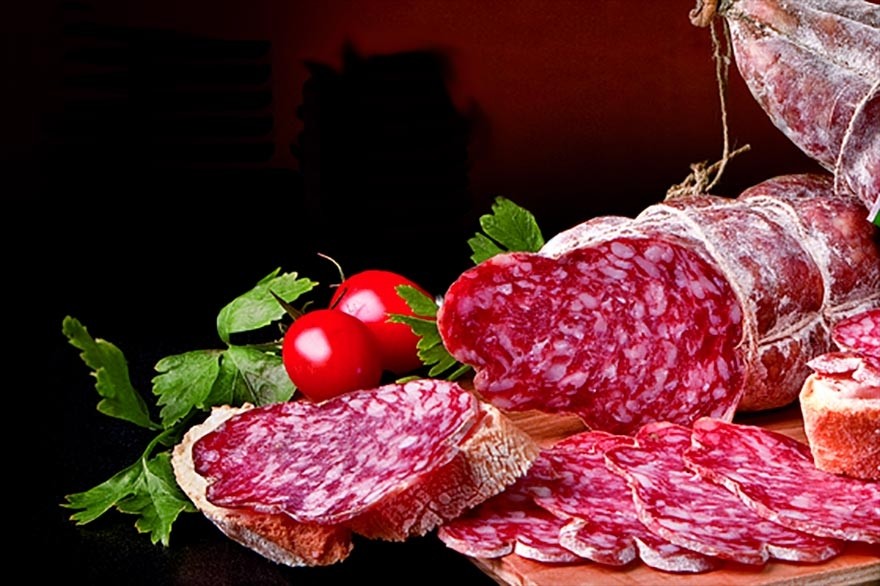Cremona Salami P.G.I.
Product description
Salame Cremona PGI is a large-grained stuffed charcuterie product, obtained through the processing of lean meat and fat from Italian heavy pigs belonging to the Large White, Landrace and Duroc breeds.
Production method
The pork used to make the mincemeat comes from the muscular part of the carcass and the muscular fat and streaked fibres, cleaned carefully and then minced in molding machines with 6 mm holes.
Once minced, the mincemeat is mixed with natural aromas like salt, spices, pepper, ground or in pieces, and crushed garlic.
Blending is carried out in vacuum machines or at atmospheric pressure for a certain length of time.
The mixture is then placed in a natural pig, cow, horse or sheep casing with an initial diameter of no less than 65 mm.
It is then manually or mechanically tied with a cord. The product can be kept in a cold storeroom for a day at the most, with a temperature between 2 and 10°C.
It is heat dried at a temperature between 15 and 25°C, in order to allow for the rapid dehydration of the superficial parts in the first few days.
Curing takes place in ventilated locations with a temperature between 11 and 16°C, for a period of no less than five weeks, based on the initial size of the casing.
Apparence and flavour
Salame Cremona PGI is cylindrical in shape and weighs more than 500 g. It has an irregular surface and a soft consistency.
The slices are compact and homogenous red in colour, with typical fragments of muscle and fat (so-called smelmato appearance).
It is has a typical aromatic and spicy fragrance.
Gastronomy
Salame Cremona PGI should be wrapped and kept in the least cold compartment of the fridge; it should be taken out a few minutes before eating.
This product is perfect to serve with local cheeses and can be eaten as a snack, diced as an accompaniment for aperitifs, or used as an ingredient in main dishes.
As a delicious alternative, it can be served with figs or pears: due to its soft consistency it is difficult to individuate the salami from the fruit,
resulting in a pleasant sensation on the palate. For the same reason, it is ideal to eat together with a croissant.
Marketing
The product is marketed as Salame Cremona PGI. It is sold whole with a weight of no less than 500 kg, in pieces or sliced, vacuum-packed or in modified atmosphere packaging.
Distinctive features
Salame Cremona PGI is still produced with procedures that fully respect tradition, incorporated with the new technologies that have been introduced to the production processes.
History
The origins of Salame Cremona PGI date back to the Romans.
There are numerous documents referring to the buying and selling of pigs by farmers who held limited partnership agreements with the owners of the animals, dividing the profit at 50% (agistment contract).
More information on the diffusion and certain fame of salami can be found in a series of Renaissance documents contained within the Litterarum and
Fragmentorum in the State Archives of Cremona. These documents reveal the presence and importance of this product in the production area.
The appearance of salami in the area of Cremona was also ascertained by the notary Ludovico Cavitelli, in his work Annales (Cremona, 1588),
as well as by a list of food consumed every day in the local convents: if salami was a basic food stuff in the convents, we can presume that it was also for the population.
Production area
The production area of Salame Cremona PGI is within the regions of Lombardy, Emilia- Romagna, Piedmont and Veneto.
Operators: 17
Production(KG): 166.126
Turnover(MLN€): 1,98

 IT
IT 